FAQs
Glass abbreviations + performance criteria definitions
DGU (Double Glazed Unit) = A glass pane made up of 2 or more pieces of glass with an airgap between. Sometimes also commonly refered to as an IGU (Insulted Glazed Unit).Low E = Coating to glass to improve thermal performance.
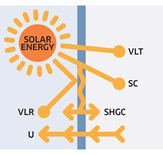
SC (Shading Coefficient) = Measured as a ratio. Total solar heat gain compared to a 3mm pane of clear glass.
STC (Sound Transmission Class) = Is an integer rating of how well airbourne sound is attenuated by the glass as a partition.
U-Value = Measured as a ratio. Measures air to air transfer through glass due to thermal conductivity of the glass unit between the inside and outside.
VLR (Visible Light Reflectance) = Measured as a percentage. The amount of visible light that is reflected from the exterior of the glass surface.
VLT (Visible Light Transmission) = Measured as a percentage. The amount of visible light that passes through the glass.
What questions do you need to ask before engaging a facade contractor?
Who is engineering the suite / system?
At Thermosash we develop and engineer and test all our own suites.
Who Signs the Producer Statements for the design and installation?
Thermosash have in-house council authorized Facade Engineers who are capable of signing off PS1 Design, PS2 Design Review, PS3, Construction, PS4 Construction Review. We can also co-ordinate with independent facade consultants where necessary on the above.
Are the systems tested?
Thermosash test the suites we design in our independently audited test booth - one of the largest in New Zealand - capable of a two-storey simulation for water / air infiltration and seismic movement.
Does anyone do a structural analysis on the project to confirm suitability for the selected suite?
At Thermosash we have in-house registered structural and facade engineers that review and engineer for wind loads, live loads, dead loads, induced maintenance loads for brackets, fixings, cast-ins, structural members, connections, glass, structural silicone and associated loads on adjoining structure.
What is the staff experience that have the appropriate capability to undertake facade management and buildability resolution?
Thermosash has highly experienced and long serving team members including Engineers, CAD Engineers, Project Managers, Architects, QA/QC staff, all focused on the successful coordination and implementation of your concept.
What is the track record of the company?
Established in 1973 - one company entity to date. Thermosash have 3 large well equipped nationwide facilities with a staff of around 220. We are a committed company to rainscreen, pressure equalization and drainage principles, well before this weathering science was recognized as being required to provide a durable solution. We run a sustainable business that ensures that we will be here to service you for your next project.
What is the company's ability to achieve project programme?
We manufacture in house, we have all our own access equipment, we have the resource, and we have the experience.
What is the company's capability?
Thermosash was established in 1973, our staff are skilled with many local years and international experience and training.
Can you provide a 10 year Warranty?
Thermosash are often able to offer a warranty in excess of the WGANZ standard form where we supply and install our suites due to our confidence of engineering and proof from in-use field testing of our suites.
Who undertakes the installation?
At Thermosash our installation crews are a mixture of in-house and contracted crews. Many of the contract staff have worked for Thermosash for many years and are trained on systems and suites and overseen by our experienced project managers.
When do I need to consider a Seismic Facade suite?
Seismic receivers in facade systems are not only specified in geographic locations subject or prone to earthquakes, but also where buildings maybe subject to movement induced by wind and where a very dynamic structure is proposed.
A conventional window suite can only absorb building movement relative to the space available around the glazing before the glass or other insert element is compromised, however the frame is directly taking raking movement and therefore its weather-tightness at the joints will be compromised.
A seismic suite is specifically designed to accommodate the specified anticipated movement calculated by the project engineer. Where windows are inserts within a precast unit (i.e. insert window) a seismic frame is not required, however when that same window is adjacent to any other material that can rake or move differentially from each, distorting the frame then the seismic frame comes into action, absorbing the movement, protecting the frame assembly and the insert glass from breaking or evacuating from the frame.
Thermosash has seismic receiver suites which have been tested and can integrate with all our commercial window systems subject to up to 75mm movement, and can specifically design systems that can go higher when necessary.
How often do you need to clean a building façade?
Almost regardless of what the façade is built of, it will require a scheduled cleaning programme. This includes glass, stainless steel, anodised and powder coated aluminium, composite aluminium panels etc. There are a few materials that do not require maintenance cleaning in order to retain their appearance or performance - in fact work better rely on nothing being done - they are zinc, lead and Weathering Steel (e.g. Corten™).
Atmospheric airborne salts and industrially generated pollutants (eg vehicle emissions) will settle on the building and if not removed either by regular rainfall and scheduled cleaning can dull the surface and over time detrimentally affect the material. Almost all material manufacturers and suppliers state that the material warranty is subject to regular maintenance and if not undertaken - warranties can be voided.
Depending on the geographical location and annual rain fall or amount of construction and duct generation locally - cleaning schedules can be as often as 3 monthly or more if in a industrial zone.
The time when materials are exposed to some of the harshest contamination is during construction - cement products can damage prefinished surfaces rapidly and require protection or staging of projects to limit any material damage from the outset.
The cleaning process is not often common across most materials and not a complicated process, normally calling for a soft wash with mildly soaped water - and then wiped dry to prevent any water spotting (particularly on glass).
If there are signs of heavy staining or other on the façade ALWAYS consult the material supplier or manufacturer for a full cleaning regime as some materials can react adversely to heavy duty cleaners.
What is a curtainwall
A curtainwall is an outer covering of the building, generally bracketed off the primary structure beyond the frame. Whilst curtainwalls are non-structural and are primarily designed to keep out the weather they can also be designed to provide thermal control, reduce acoustic transmission, provide air barriers and also allow for the cladding to absorb wind loading and seismic vertical or horizontal movement. Due to the non-structural nature of the curtainwall, the materials they are made from can be lighter – often aluminium for the main frames with glass or aluminium panels being the most prevalent. However almost any other material can be incorporated into the system as desired by the designer, such as metal panels in pressed aluminium, stainless steel, zinc, copper or ACM (aluminium composite materials) or terracotta tiles – to name but a few.
The curtainwall can provide large amounts of natural light with a seemingly very light structure. Floor connections for the primary structure must be able to receive the load of at least one floor of the curtainwall and manage the transfer of the wind-loads, service and seismic loads imposed upon it. As with all large expanses of glass, the building services consultant must define any solar gain, shading, reflectance, thermal loss etc for the building so that the specified glass and infill panels can meet this requirement, either solely or via the incorporation of ancillary solar control devices, such as louvres or vertical fins, operable windows, vents or even twin skin structures. These are all able to be incorporated into the Stick System Suites such as the Thermosash CW400, CW600, sloped Alpha skylight systems or the stick / unitized Thermosash Delta Suite.
Curtainwalls differ from the conventional rain screen cladding build up because Thermosash curtainwalls allow for thermal expansion and contraction, building sway, water diversion and thermal heating, cooling and lighting within the building.
What loads need to be considered when designing a curtainwall?
Curtainwalls must be designed to absorb and transfer all the loads that are imposed on it back into the building primary structure via the brackets attached to each mullion. The building's engineer must account for these loads, and by making the structure too light will only necessitate the curtainwall engineering having to absorb greater amounts of movement.
Dead Load
The dead load is the term used for the weight of the unit as it 'hangs' from the building's structure. In the case of curtainwalls, this comprises the mullions, transoms, glass or any other infill material that is part of the curtaiwall (stick or unitised). Additional consideration should be made for signage, sunshades, maintenance platforms etc that must be transferred back to the building's structure via the curtainwall connection brackets.
Wind Load
Wind loads can vary greatly across New Zealand and the South Pacific and are a critical force on a building's structure and the façade system. It is highly recommended that wind studies are undertaken on medium to highrise buildings to ascertain the expected wind pressures to the façades – not just on the middle face of the façade but specifically to the corners where often significantly higher readings are found. On large or tall or oddly shaped buildings, wind tunnel tests are undertaken to test the building shape and influences that surrounding topography or other nearby buildings may have on the project. Once the wind pressures have been ascertained, Thermosash can assist interpreting these into a specific engineered design solution for your project.
Seismic Load
Seismic loads need consideration early in the design process of a curtain or unitized wall system. New Zealand has some of the highest seismic code requirements in the world. In almost all circumstances the façade must be specifically designed to suit the intended movement from the engineer's calculations, however in most situations, curtain and unitized panel wall systems are able to withstand seismic and wind movement upon a building generally up to 75mm. This is largely because the curtain and unitized panel wall systems are offset from the structure of the building and the brackets, anchoring systems and glazing engagement systems are designed to receive and absorb such movement relative to the primary structure movement often without glass breaking, water leaking or disengagement of panel inserts or other such critical failure of the façade system.
At Thermosash we have been seismically testing our suites since 1989. The Christchurch earthquakes of 2010/2011 tested our engineering with pleasing results with many of our built façades continuing to perform as originally designed without any repair work required.
How are curtainwalls installed
The use of monorail / floor cranes / Thermosash flexidecks / mast climbers all largely eliminate the need for scaffolding the exterior of the building in order to install the façade panels. This also takes pressure off the site cranes during the construction process as they are only required to load the floors with the curtainwall panels.
A simplified process for a typical unitized panel:
- Panel is designed, engineered and shop drawn.
- Manufactured in frame factory.
- Enters the glazing line - once glazed, structural sealant must cure.
- Approx 30% of the building façade is stored prior to commencement on site.
- Site teams install floor brackets off cast-in plates in concrete floor.
- Panels are trucked to site in racks.
- Tower crane lifts racks to each designated floor.
- Site install teams launch each panel off the floor in a predetermined direction (almost always from the bottom up).
- Each panel has a male-female section that, with the aid of gaskets, lock into each adjoining panel.
- Panels are restrained back to each floor with bolted brackets at the head for dead load- often covered behind data / power strips or within ceiling space.
Are Thermosash curtainwalls fire rated?
The majority of Thermosash suites are manufactured from aluminium which has a relatively low fire melt point and are therefore not able to provide fire cell ratings. Thermosash systems can however provide smoke stop floor to floor and fire stop when there is a spandrel incorporated with a thin gauge steel backpan with a curtain wall approved fire stop material wedged between floors. We undertake this when required as part of our contract. This is a tested system - should your Fire Engineer require further information we can forward copies of this test.
Where a fire rated wall is required steel joinery with specialty fire rated glass or a similar solution should be sought.
Do Thermosash supply glass as part of the curtainwall system?
Yes, always - Thermosash provides Building Envelope Solutions - of which glass is a significant part of the system. For most façade systems, these are factory prefabricted - therefore the glass is glazed in the unit in the factory - often structurally glazed in factory controlled conditions.
Thermosash have subsidary commercial glass and glazing companies called Woods Glass and Bowden & Trent whom have technical glass specialists to help procure the best glass solution available.
What is the 'R' or 'U' value for your curtainwalls
Unitized curtainwalls can almost be engineered to have as high an 'R' or 'U' value rating as desired - ultimalty the glass is the weakest link. However with the glass technology available today the thermal performance capability of glass is impressive.
Thermosash Stick System curtainwalls are thermally broken and our PW1000 has the least amount of external metal exposed to the outside temperature of any of our suites, thereby limiting the potential of acting as a thermal bridge.
Spandrel panels almost always are designed to include insulation providing thermal rating to meet the mechanical performance specification - typically R2.6, or higher as specified.
How are curtainwalls fixed to the structure?
Curtainwalls as described briefly in the FAQ 'What is a curtainwall' explains that they are as the name suggests 'hung like a curtain'. Whether it is a curtainwall or a unitised panel system the fixing principle is much the same. Plates are cast into the concrete floor of the building and brackets are welded to these plates based on very accurate surveys of the building. The brackets are installed with an allowance generally of 50mm from the edge of the concrete slab to the rear of the curtainwall to allow for building tolerance uptake.
Following international design principles, the bracket at the head of the curtainwall is designed to support the deadload of the curtainwall whilst the engagement system at the bottom of the panel is designed to withstand the windloads. Due to the engagement mechanisms, curtainwalls are designed to be installed following a direction around the building - and almost always from the ground up.
What is the recommended set off from horizontal concrete beams or floor slabs?
Curtainwall and unitised systems are installed to incredibly accurate vertical and horizontal tolerances (we cut assemble and install to within +/-3mm). Regrettably on-site concrete and steel work does not align with these tolerances therefore, to allow for structure tolerance absorption, the curtainwall fixings and an allowance for horizontal smoke seals between floors we request a 50mm offset from the slab edge.
What are the advantages of 'Twin Skin' curtain wall
Twin skin curtainwalls allow for a building to passively condition the air to the spaces inside. The build up consists of from the outside to the internal:
- High performance glass
- A gap of approximately 600mm with Shadegrate™ access floor system (to allow air to move passively up through the building floors.
- High performance glass to the internal line.
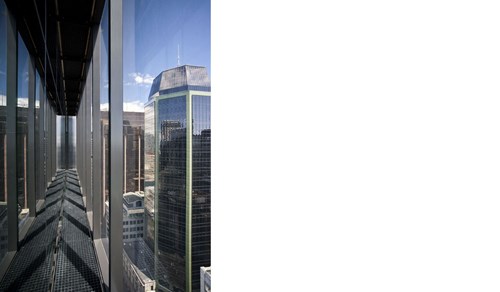
At the upper and lower levels as per the mechanically engineered design, there are controlled dampers or sashes that allow the cool air to enter the building. Due to the natural warming of the air behind the first glass layer, the air moves naturally upwards causing a draught. This draught has a natural cooling effect on the inner pane of glass and also keeps the air moving throughout the day thus limiting the amount of solar heat gain the glass would otherwise be subjected to.
On cooler days the dampers will close and the trapped air acts as a thermal cavity reducing the cold effect to the inner glass.
It has been proven that incorporating this natural cooling principle in buildings can save significant amounts of cooling capital equipment required within a building, saving long term on initial capital outlay, running and maintenance costs.
What is a unitized panel
The unitized panel is a similar principle to the conventional stick system curtainwall. In much the same way, unitized panels enable rapid site assembly and installation, largely independent of weather conditions. The prefabricated nature of the unitized panels guarantees an exceptionally high factory quality controlled construction quality.
The unitized panels are non-structural and, whilst primarily are designed to keep out the weather, can also be designed to provide thermal control, reduce acoustic transmission, create air barriers, allow for the cladding to absorb wind loading and seismic vertical or horizontal movement. As with the Thermosash curtainwall suites, almost any other material can be incorporated into the system as desired by the designer such as metal panels in pressed aluminium, stainless steel, zinc, copper or ACM (aluminium composite materials) or terracotta tiles – to name but a few .
The curtainwall can provide large amounts of natural light with a seemingly very light structure. Floor connections for the primary structure must be able to receive the load of at least one floor of the curtainwall and manage the transfer of the wind-loads, service and seismic loads imposed upon it. As with all large expanses of glass, the building services consultant must define any solar gain, shading, reflectance, thermal loss etc for the building so that the specified glass and infill panels can meet this requirement either solely or via the incorporation of ancillary solar control devices, such as louvres or vertical fins, operable windows, vents or even twin skin structures. These are all able to be incorporated into unitized panels which can be designed to be installed independently of a support mullion such as the Thermosash PW400, PW600, PW800 or PW1000 or within a stick system such as the Alpha CW400, CW600 or the sloped Alpha skylight system.
Thermosash unitized panels differ from the conventional rain screen cladding build up because they allow for thermal expansion and contraction, building sway, water diversion and thermal heating, cooling and lighting within the building.
What is the difference between stickwall and unitised?
Original curtainwalls were manufactured as stickwall - literally made from sticks of aluminium.
The aluminium was generally cut, drilled and slotted etc off site and brought to site and assembled. The advantages of this system was the speed of assembly - originally introduced so that the façade could keep up with the speed of American high rise steel construction. Once the aluminium was installed, commercial glaziers would follow up the building enclosing the building behind with glass.
As there was little factory work required, the period of time between building design and construction to façade installation offered programme advantages.
However with the advent of Unitised panel construction (refer unitised above in FAQ) and the added complexity of building designs coupled with clients looking for greater variance in cladding material assemblages, the benefits of a full factory assembled system offers further programme advantages in areas such as greater surety in weatherproofing, and often requires less on-site labour.
What is a ‘Green Wall’?
Suspension type green walls using a climber rather than sucker plants are commonly supported from tensioned stainless steel rods or wire with technical componentry to create a vertical garden. Green façades are not only appealing but they are also very beneficial.
A green façade helps regulate interior temperature of buildings by promoting an insulating layer of air, reducing the potential of direct solar radiation on the façade and almost providing a natural air-conditioning when incorporated with operable windows – reducing the demand on air-conditioning systems. Additionally a well-designed green façade will provide a level of weather protection from rain and reduction in ultraviolet radiation to the building façade.
At Thermosash we have chosen to work closely with a leading supplier in this technology from Switzerland.
The options are limitless with Thermosash and Jakob Green Solutions. View: Jakob Green Solutions Brochure
What are the limitations on the Storefront / Shopfront suites
Shopfront suites are commonly named such as they are incorporated at street level, commonly protected from the extremes of the weather. The suites incorporate minimum technology in terms of drained and pressure equalized cavity technology. The suite generally should not be relied on where the building requires extreme weather proofing, but instead provides an economical solution to installations under verandas, shopping mall and interior partition fit out installations.
What is a Rainscreen?
The word ‘Rainscreen’ is often misunderstood. Whilst it screens the rain, it is not a system that is weather resistant without an air barrier behind it performing the function of equalising the air pressures, thus preventing moisture coming into the building.
For example, brick veneer is a rainscreen but without the building paper or Rigid Air Barrier in the cavity behind it, it would likely cause the building to leak.
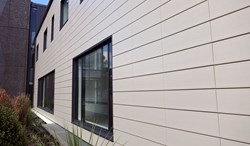
Generally a rainscreen cladding consists of an outer weather-resistant material to provide the decorative element to a building, fixed to an secondary structure by means of a which maintains the ventilated and drained cavity between the façade and the structure. Rainscreen façades can be open jointed or sealed (but must accommodate a drainage mechanism to the outside) and would have a ventilation cavity of at least 25mm immediately behind the cladding panel.
Rainscreen cladding must always be incorporated with an air barrier behind designed to meet the wind pressures generated by the site location, topography of the site and the height of the structure.
What is an Air Barrier (Rain Screen Principle)
A common feature in curtainwall technology is that of the Rain Screen Principle, which is based on three principles –
- Water to the exterior face.
- Openings to permit the water's passage.
- Forces to drive or draw the water in.
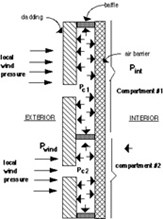
Remedies to the three causes are:
- Rain screen on the outside to protect the drainage.
- Air seal on the inside – kept dry.
- Drainage of a cavity to the outside away from the air seal.
In essence; eliminate the pressure differential across the opening to equalise the pressure on its opposite sides. An Air Barrier can be formed with building papers or by a Rigid Air Barrier (RAB). The selection is often based on designed wind pressures as applicable for the project. An air barrier must meet air infiltration tests and tests to destruction under high wind pressures to confirm suitability prior to specification. Often leaks found in buildings façades can be attributed to poor performing or poorly specified air barriers behind rain screen type claddings. Pressure equalisation should not be misconstrued with a more ‘conventional’ and long accepted method called “theory of secondary defence” which depends largely on a drainage system within a cavity.
Whilst this simple method has also proven to work, conversely incorporating the rain screen principle into aluminium joinery can be very complicated and involve careful and often ingenious detailing to achieve a quality pressure equalized curtain or unitized panel wall solution.
All Thermosash suites are tested with wind and water combinations to exceed the code and standard requirements undertaken in the largest testing facility in the southern hemisphere.
What is an IGU?
IGU = Insulated Glass Unit, a fancy name for a Double Glazed Glass Pane. IGUs are essentially a sandwich of glass with an air gap in-between with the primary objective of reducing the transfer of thermal loss or gain between the inside and outside.
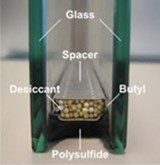
The air gap between the two (or three) sheets of glass contains desiccant which aids in absorbing any moisture which is trapped inside the sealed units, whilst high performing IGUs can have argon gas injected into the cavity to increase the thermal performance of the element. Whilst IGUs also offer some acoustic* and potentially security* benefits it is important to note that IGUs are specifically made and cannot be cut down if the opening is a little smaller!
What is ULS?
ULS = Ultimate Limit State. For a structure to satisfy the ultimate limit state, the structure or constituent element must not collapse or fail when subjected to the peak design load for which it was designed i.e. wind or seismic events. A structure is deemed to satisfy the ultimate limit state criteria if all factored bending, shear and tensile or compressive stresses are below the factored resistance calculated for the section under consideration.
These values are normally expressed in millimetres and determined by the structural engineer on the project. For a building element to be considered still in service after an event specifying the elements to meet a ULS measure is important. It should be noted however that events can be far greater than those designed for. Thermosash has been testing and installing building façades in our own largest testing facility in the southern hemisphere since 1989.
What is SLS?
SLS – Serviceability Limit State. To satisfy the serviceability limit state criteria, a structure must remain functional for its intended use subject to routine loading. A structure or building element is deemed to satisfy the SLS when the constituent elements does not deflect by more than certain limits laid down in the building codes.
A serviceability limit state is less than an ultimate limit state and, as such during a more significant seismic event, a structure or building element only designed to an SLS may include apparent failure of a structure whilst the structure itself has not completely failed, allowing users of the building to exit safely but necessitating the replacement or major repair of significant building elements.
Advertising film or stickers on glass
Often not considered early on in a project is the potential to use a building façade for advertising a major event, for example.
Due to the high performance nature of glass, this needs to be considered early on in the specification as some vinyl graphic films and glass are not always compatible. If the glass has not been designed in consideration of large amounts of vinyl on it, it may be subject to disproportional shading, causing the glass to undergo a form of thermal stress and potentially causing the glass to fracture.
Please consult with us if this is a possibility with your project.

